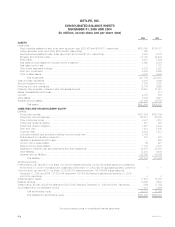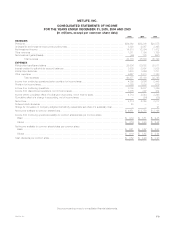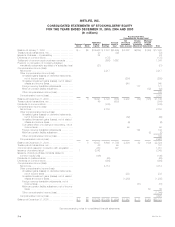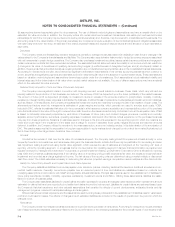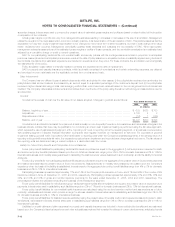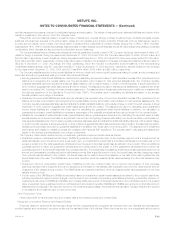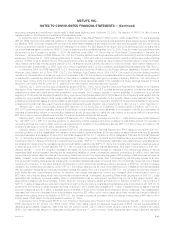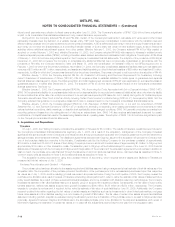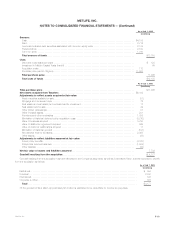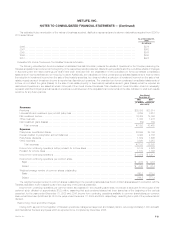MetLife 2005 Annual Report Download - page 73
Download and view the complete annual report
Please find page 73 of the 2005 MetLife annual report below. You can navigate through the pages in the report by either clicking on the pages listed below, or by using the keyword search tool below to find specific information within the annual report.METLIFE, INC.
NOTES TO CONSOLIDATED FINANCIAL STATEMENTS — (Continued)
derivatives are exclusive of any accruals that are separately reported in the consolidated statement of income within interest income or interest expense
to match the location of the hedged item.
Under a cash flow hedge, changes in the fair value of the hedging derivative measured as effective are reported within other comprehensive income
(loss), a separate component of shareholders’ equity, and the deferred gains or losses on the derivative are reclassified into the consolidated statement of
income when the Company’s earnings are affected by the variability in cash flows of the hedged item. Changes in the fair value of the hedging instrument
measured as ineffectiveness are reported within net investment gains (losses). The fair values of the hedging derivatives are exclusive of any accruals that
are separately reported in the consolidated statement of income within interest income or interest expense to match the location of the hedged item.
In a hedge of a net investment in a foreign operation, changes in the fair value of the hedging derivative that are measured as effective are reported
within other comprehensive income (loss) consistent with the translation adjustment for the hedged net investment in the foreign operation. Changes in
the fair value of the hedging instrument measured as ineffectiveness are reported within net investment gains (losses).
The Company discontinues hedge accounting prospectively when: (i) it is determined that the derivative is no longer highly effective in offsetting
changes in the fair value or cash flows of a hedged item; (ii) the derivative expires, is sold, terminated, or exercised; (iii) it is no longer probable that the
hedged forecasted transaction will occur; (iv) a hedged firm commitment no longer meets the definition of a firm commitment; or (v) the derivative is de-
designated as a hedging instrument.
When hedge accounting is discontinued because it is determined that the derivative is not highly effective in offsetting changes in the fair value or
cash flows of a hedged item, the derivative continues to be carried on the consolidated balance sheet at its fair value, with changes in fair value
recognized currently in net investment gains (losses). The carrying value of the hedged recognized asset or liability under a fair value hedge is no longer
adjusted for changes in its fair value due to the hedged risk, and the cumulative adjustment to its carrying value is amortized into income over the
remaining life of the hedged item. Provided the hedged forecasted transaction is still probable of occurrence, the changes in fair value of derivatives
recorded in other comprehensive income (loss) related to discontinued cash flow hedges are released into the consolidated statement of income when
the Company’s earnings are affected by the variability in cash flows of the hedged item.
When hedge accounting is discontinued because it is no longer probable that the forecasted transactions will occur by the end of the specified time
period or the hedged item no longer meets the definition of a firm commitment, the derivative continues to be carried on the consolidated balance sheet
at its fair value, with changes in fair value recognized currently in net investment gains (losses). Any asset or liability associated with a recognized firm
commitment is derecognized from the consolidated balance sheet, and recorded currently in net investment gains (losses). Deferred gains and losses of
a derivative recorded in other comprehensive income (loss) pursuant to the cash flow hedge of a forecasted transaction are recognized immediately in net
investment gains (losses).
In all other situations in which hedge accounting is discontinued, the derivative is carried at its fair value on the consolidated balance sheet, with
changes in its fair value recognized in the current period as net investment gains (losses).
The Company is also a party to financial instruments that contain terms which are deemed to be embedded derivatives. The Company assesses
each identified embedded derivative to determine whether it is required to be bifurcated under SFAS 133. If the instrument would not be accounted for in
its entirety at fair value and it is determined that the terms of the embedded derivative are not clearly and closely related to the economic characteristics of
the host contract, and that a separate instrument with the same terms would qualify as a derivative instrument, the embedded derivative is bifurcated from
the host contract and accounted for as a freestanding derivative. Such embedded derivatives are carried on the consolidated balance sheet at fair value
with the host contract and changes in their fair value are reported currently in net investment gains (losses). If the Company is unable to properly identify
and measure an embedded derivative for separation from its host contract, the entire contract is carried on the balance sheet at fair value, with changes
in fair value recognized in the current period in net investment gains (losses).
Cash and Cash Equivalents
The Company considers all highly liquid investments purchased with an original or remaining maturity of three months or less at the date of purchase
to be cash equivalents.
Property, Equipment, Leasehold Improvements and Computer Software
Property, equipment and leasehold improvements, which are included in other assets, are stated at cost, less accumulated depreciation and
amortization. Depreciation is determined using either the straight-line or sum-of-the-years-digits method over the estimated useful lives of the assets, as
appropriate. The estimated life for company occupied real estate property is generally 40 years. Estimated lives generally range from five to ten years for
leasehold improvements and three to seven years for all other property and equipment. The cost basis of the property, equipment and leasehold
improvements was $1,418 million and $1,258 million at December 31, 2005 and 2004, respectively. Accumulated depreciation and amortization of
property, equipment and leasehold improvements was $625 million and $565 million at December 31, 2005 and 2004, respectively. Related
depreciation and amortization expense was $117 million, $112 million and $117 million for the years ended December 31, 2005, 2004 and 2003,
respectively.
Computer software, which is included in other assets, is stated at cost, less accumulated amortization. Purchased software costs, as well as internal
and external costs incurred to develop internal-use computer software during the application development stage, are capitalized. Such costs are
amortized generally over a four-year period using the straight-line method. The cost basis of computer software was $1,010 million and $868 million at
December 31, 2005 and 2004, respectively. Accumulated amortization of capitalized software was $661 million and $552 million at December 31, 2005
and 2004, respectively. Related amortization expense was $111 million, $139 million and $154 million for the years ended December 31, 2005, 2004
and 2003, respectively.
Deferred Policy Acquisition Costs and Value of Business Acquired
The costs of acquiring new and renewal insurance business that vary with, and are primarily related to, the production of that business are deferred.
Such costs consist principally of commissions and agency and policy issue expenses. VOBA, included as part of DAC, represents the present value of
estimated future profits to be generated from existing insurance contracts in-force at the date of acquisition.
DAC is amortized with interest over the expected life of the contract for participating traditional life, universal life and investment-type products.
Generally, DAC is amortized in proportion to the present value of estimated gross margins or profits from investment, mortality, expense margins and
MetLife, Inc. F-11



